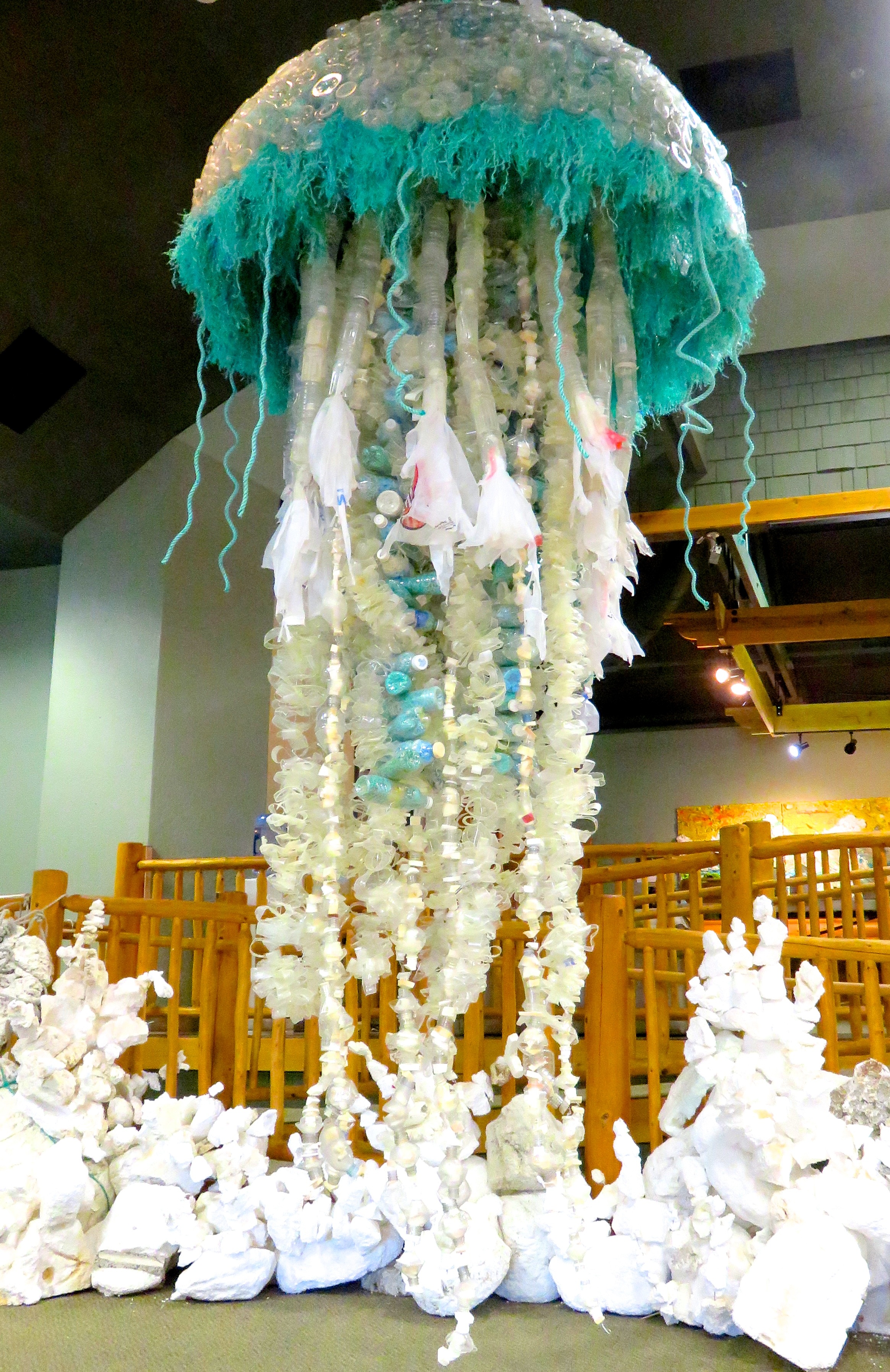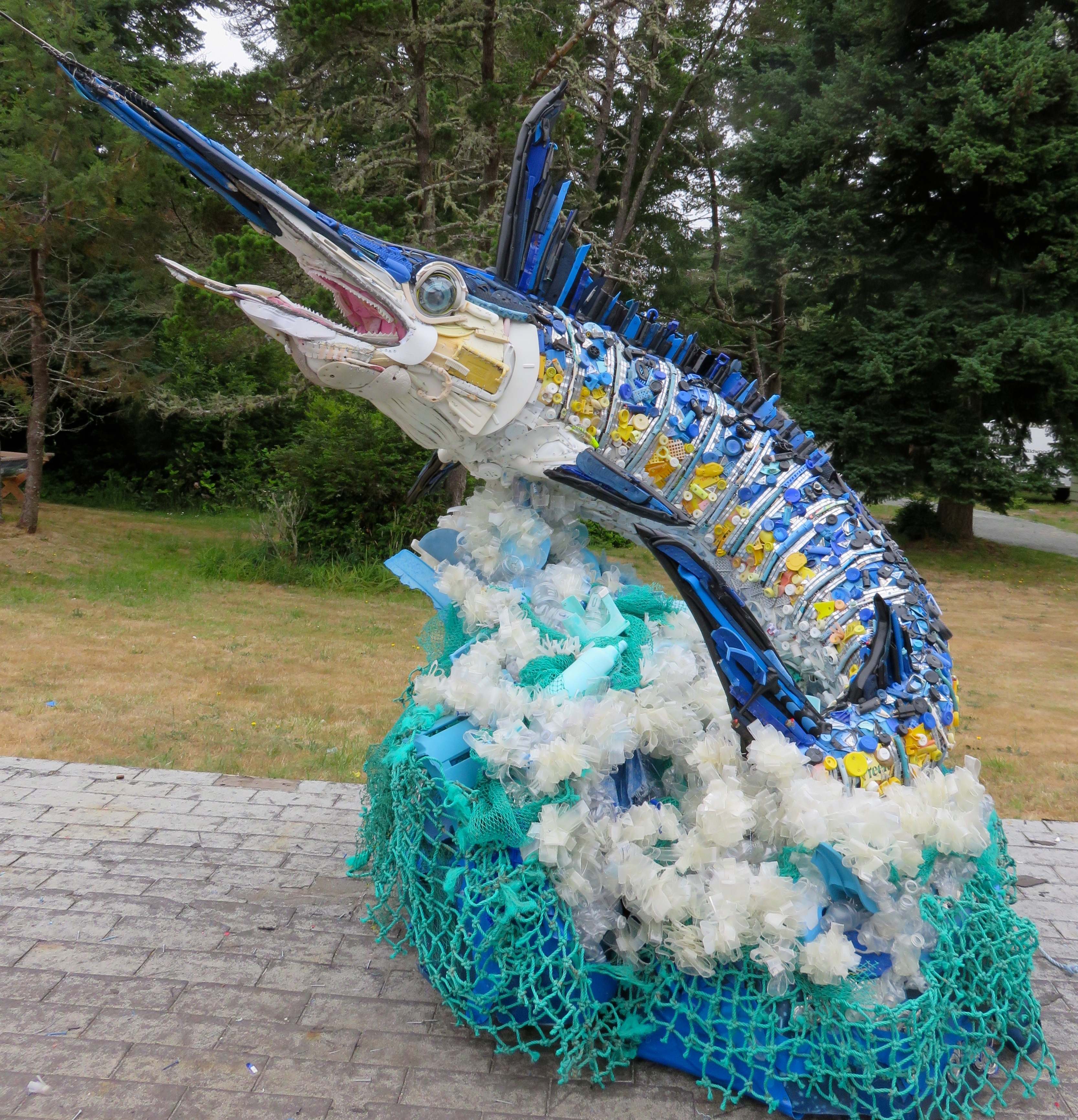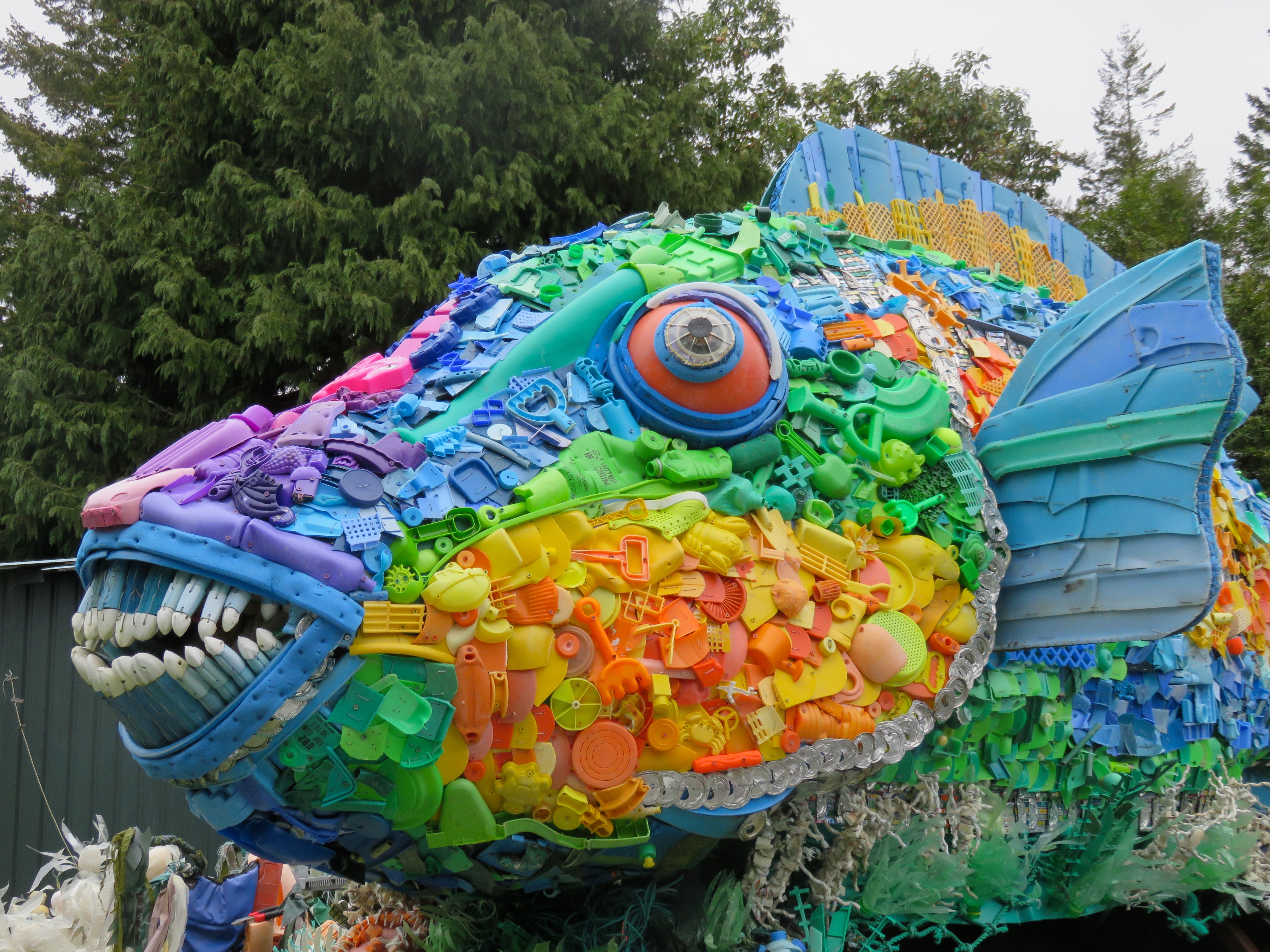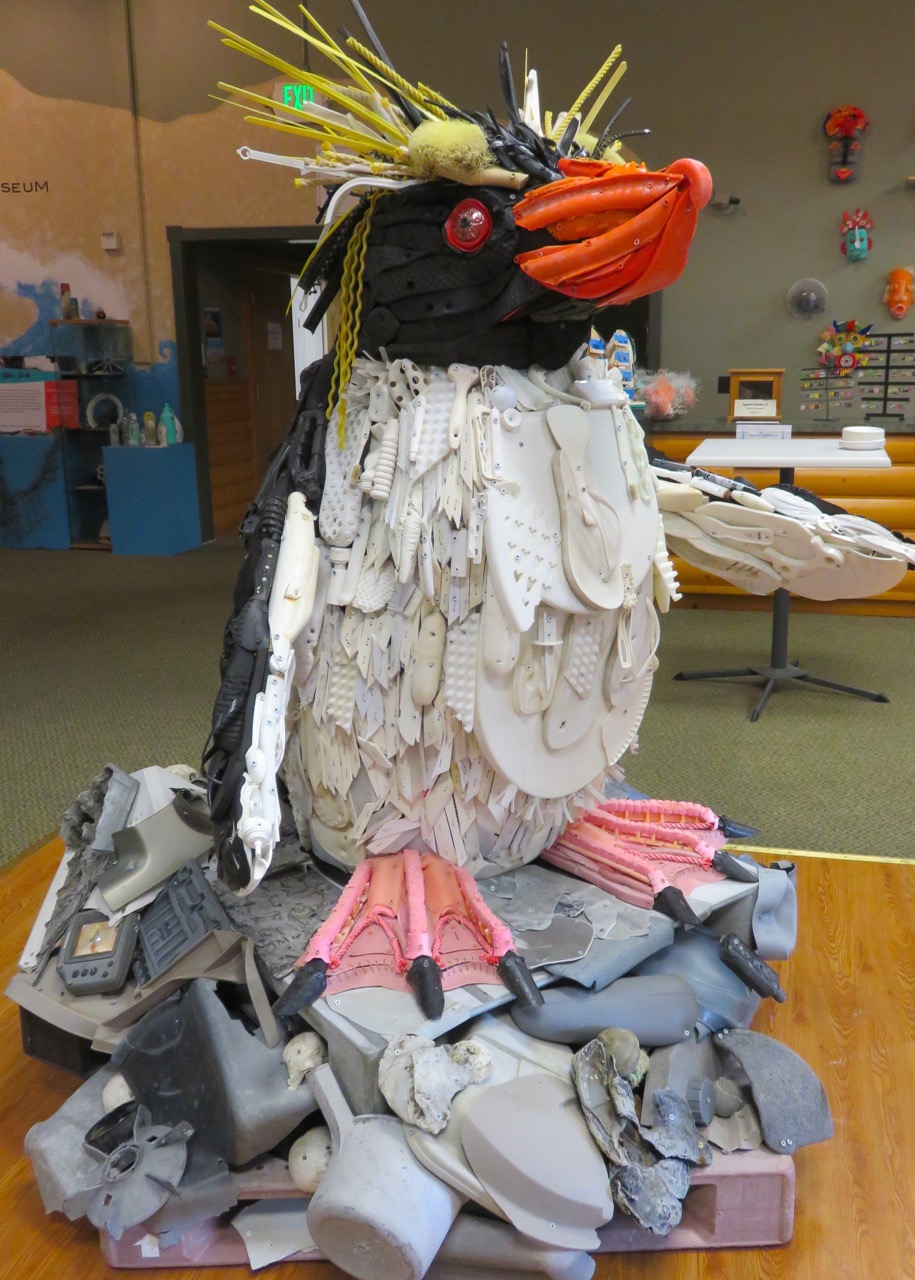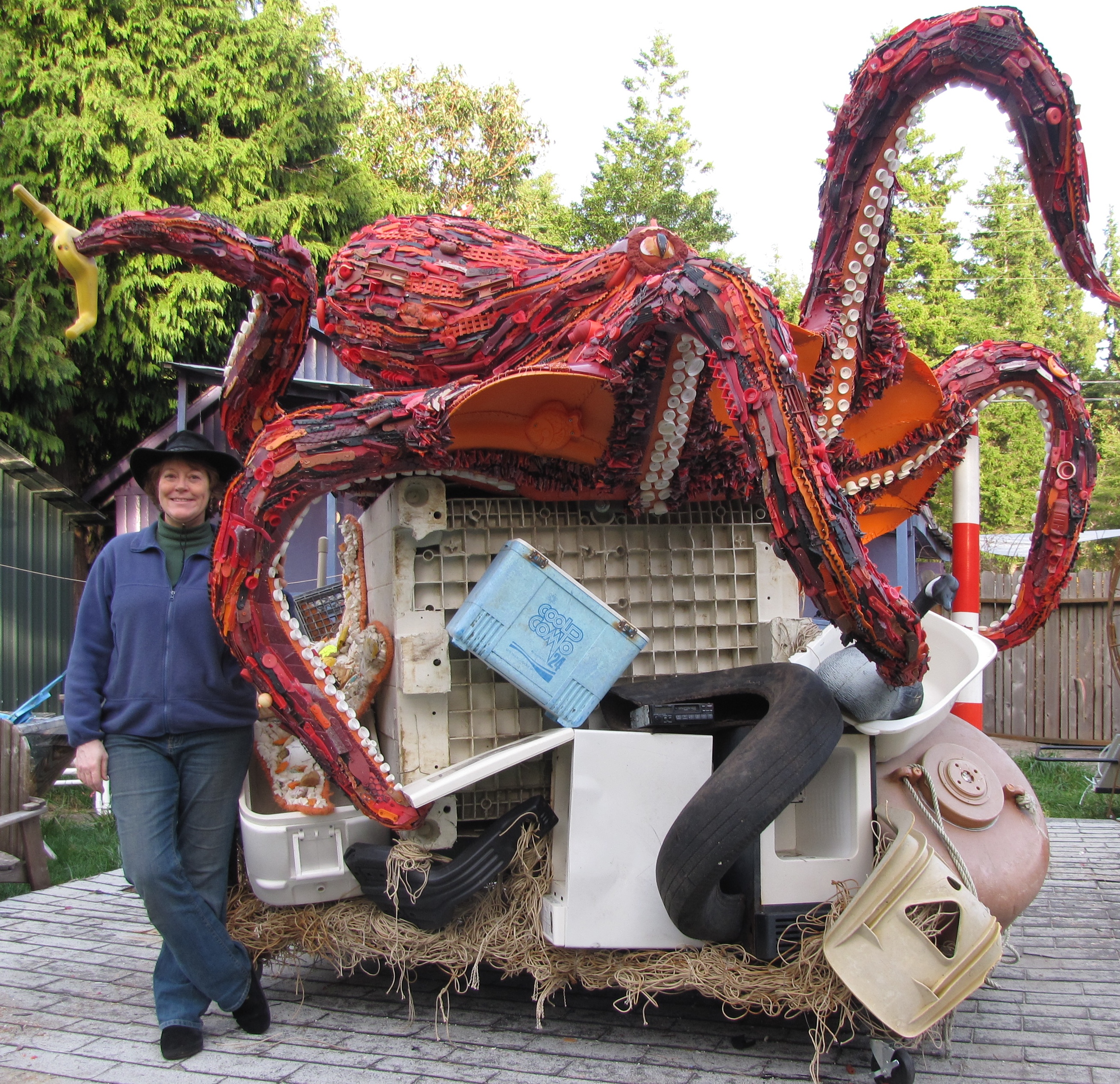Since 2010, Angela Pozzi’s Washed Ashore project has transformed an astonishing 20 tons of marine trash into over 70 works of arresting larger-than-life public art works, drawing much-needed attention to the epidemic of plastic pollution and its negative impact on endangered species. What started as Pozzi’s personal attempt to keep a beach beautiful has become a global call to action with shocking visual and educational impact, as the lifelong sculpture artist and her team of volunteers harness the power of collective work to start a revolution in the way we approach our beaches. The medium is, truly, the message. Oceanic Global spent an hour in conversation with Pozzi, learning about the surprising origins and exciting growth of Washed Ashore. The interview has been edited for clarity and length.
Can you tell us about your background and the origins of Washed Ashore?
First of all, I’ve always loved the ocean. It’s where I spent all my summers as a child; it was always the place where it felt like I connected to the world.
I was also raised by two artists, and I grew up realizing that the arts are an important language, and that I was very privileged to be able to speak those fluently. As I grew up, I kept wondering why nobody else understood art like I did, and I decided to become an art teacher because I thought: it doesn’t seem right that people don’t understand how important art – all the arts – are. I eventually became an art teacher for 30 years — art and creative dance — and I helped start two arts magnet schools, where you integrate all the arts into the subject areas, in the Portland, Oregon area.
What were you working on before Washed Ashore happened — and how did this project really come alive?
In my own artwork, I scrounged materials from thrift stores and found objects; I was an exhibiting artist starting in about 2000. I was married to an artist and teacher, Craig Pozzi, and we both were doing the same kind of thing. We were married 24 years before all of a sudden he had a massive collapse and was rushed off to emergency brain surgery with a brain tumor. We didn’t know what was going on, but he came through that. Then a year later he had a massive stroke; he was disabled. And a year later, he died.
We were very close, and I was just a wreck. We were living in the Portland area, and the only thing I could think of to try to find a reason to live and a reason to do art was to go to the ocean. So I said to myself, I’ll get to the ocean where I can try to heal and see beauty and try to find my purpose in life.
So I moved to Bend in Oregon, where my family had a cabin on a little lake for 85 years. I took my dog to the beach every day and walked the beach. At first I kind of stepped over the garbage. There wasn’t a lot of it; there was just a little bit here and there. I just didn’t want to see it, because I needed beauty. But it still kept nagging at me – what is that stuff on the sand?
I walked onto this one beach and I was just shocked. There was a rack line of plastics going away as far as the eye could see. I was absolutely horrified.
I saw people along the shoreline picking up agates and shells with their little buckets, and I thought, I have to figure out how to get those people to pick up this stuff. And I have to get them to see. Because we can’t not see it — this is bad.
So I decided to only use garbage from the beach as my medium.
I knew from my father, who was director of the Washington State Arts Commission for 12 years and had done a lot of work with public art – I knew it had to be public, and it had to be big. The biggest issue with public art is it’s not big enough; people ignore it, people don’t see it.
So I thought, it has to be big, and it has to be something that everyone loves — so animals that were threatened by marine debris. So I thought: how about a big fish that everyone wants their picture taken next to, and can go viral? And everything came together, and suddenly I found a purpose in life.
Ideally this will reach people globally, and we’ll have it be an epidemic art exhibit, where everyone will see it – and we’ll start Washed Ashore projects in other parts of the world, and they would make sculptures from their beaches and they would tour them, and spark another person.
Now it’s six years later. We started the whole non profit in 2010. I have 9 employees, and 10,000 volunteers.
Can you talk a little about the physical process – how long does it take to complete one of these massive works? Are there any particular challenges involved in collecting the debris and getting people together to do it?
That’s the one thing that I really like to tell people: you don’t have to organize a beach cleanup. We have constant influx of garbage.
People drop off the raw debris. Then we sort through it, using pretty much everything, about 95% — which is a real challenge, creatively, because I don’t want to recycle any of it; I want people to see how much there is. If I recycled all the water bottles, then nobody would realize how many water bottles wash ashore. The only things we don’t use are toxic things or stuff that’s too photo-degraded for us to use.
Once we hose everything down, we start sorting it by type of things. Then we vinegar wash, and use biodegradable soap. We scrub it, we scrape it; we put things in our aging yard that have too many barnacles attached, and let the raccoons and the slugs do their job. We let the rain do its job. And then we sort it by color.
From there, it’s a constant design process. We never, ever supplement with anything that’s not from the beach.
So locals in your town are used to being a part of this?
Oh, yes. We also live in a tourist town, so we get people from all over the world. We’ve processed about 20 tons of garbage now into about 70 sculptures. And we’re making new ones all the time.
What kind of team are you working with that’s helping you doing the construction for the pieces?
That’s the exciting part: we rely on volunteers for a massive amount of it. We bring in little parts of things that people can wire-stitch together. We have stuff that kids can do that are 3 years old, and we have things for adults that are more complex. I have a workshop space at our gallery where people can come in: they can stay for 15 minutes, they can walk through, or they can sit down and make a part of the sculpture.
All those parts are quality checked – everything has to be 100-mile-an-hour windproof, because they might end up outside. And those parts of pieces come back to the sculpture processing, and I have an apprentice and art assistant that work with me to attach those pieces to the big steel frame – we have a welded steel frame that we create. But it’s a strange, strange world, to work with marine debris. You can’t plan too far ahead unless you know something that’s commonly washed up.
So you said there are about 70 works you’ve created over the last 6 years or so – what happens to them? What’s the future of these pieces?
Some of those pieces are on permanent sites, where they were commissioned. Mostly we find that exhibiting at zoos, aquariums, and science centers is really a great way of getting the message out, because we connect with their education staff, and sometimes the animal is right there, so their education connects with what our message is.
We have three touring exhibits right now, one at the Georgia Aquarium, one at the Smithsonian National Zoo, and then we have our exhibit hall here in Bend. Next year we’re already booked through the entire year at botanical gardens as well, a science museum, and a zoo.
Do you have a specific memorable experience in your career as an artist and as an ocean advocate that stands out to you as a big accomplishment, or something you’re really excited about?
There are two of them.
I remember this one woman who came into the exhibit, and she stood there and she just started crying. I went up to her, and I asked her, “Is there anything I can answer? Are you doing OK?”
And she said, “This has impacted me so powerfully. I will never look at the world the same. What can I do?”
I’ve seen it several times: our work just brings people to tears. The arts can reach the heart in a way that facts and figures and science just can’t do sometimes. Over and over, I hear: this has changed the way I think about the world. And I go, Great! That’s a good start. That fuels me to keep doing this work.
What kind of reaction would you like people to have to these pieces – and what message do you want them to take away?
I want people to stop and think about what they’re doing. To make better choices. As consumers, if we can demand something different, we can make a difference.
We’re not a political activist organization. I’m very careful about that; we want the doors open to work with everybody.
The one other thing that’s personally the most significant thing that’s ever happened is that I was asked by the Smithsonian Museum of Natural History to do a display case for them. I’ve never felt so much pressure to do things right, and do things scientifically. I just completed that and installed it in June of this year; it should be there for 1 to 3 years. I tried to make it rich with teachable moments. It’s 12-foot long, a endangered Hawksbill turtle tangled in net, swimming over a reef that’s bleaching out, surrounded by sea jellies and a plastic bag.
It’s a huge honor.
What’s next? What would you like to work on next?
We have had quite a bit of interest in the satellite projects. We’ve been growing so fast that we’re trying to make sure that we’re able to go overseas, which would be wonderful, but that’s a huge jump for a small non-profit.
I think having some permanent pieces in zoos and aquariums is a really great next step for us — to make sure that this messaging is constant, that it’s always there.
If there’s one thing that you think people should do, or that you’d like them to walk away from seeing your art doing, what is that thing?
Stop using plastic water bottles. So simple! It’s so simple. Buy a reusable water bottle. And plastic bags – eliminate a plastic bag, and use a reusable bag.
What is the weirdest thing that’s washed up and come into your studio that you’ve incorporated into a piece?
Well, you know, I don’t think there’s anything weird at this point because I’ve seen so much. The most profound, amazing, and constantly shocking thing that I find are the bottles – usually lotion bottles and motor oil containers – with bite marks in them. It’s so obvious that the fish are eating it; it simply can’t be denied. When you see these, it’s like, oh my God, what’s that doing to the animal? Every time I see one, it gets me.
It’s really funny because at the very beginning of this project I presented to a group of scientists about what I was doing, and I showed this piece. And afterwards a group of scientists came up and gathered around me, and they said, you have to keep doing this work. You can show things and say things that we can’t in science. And people will see it, and you’ll start having impact before the science comes out.
Now the science is coming out, six years later. But when you actually see this stuff – you can’t deny it. It’s right there in front of you.
Is there anything else you’d like to add?
There’s one thing I really value about Washed Ashore, and that is that we’re a metaphor for how we can help solve environmental issues. We work with hundreds and thousands of people that just make one little contribution. They may not even see the final product, but they had faith that the small action would help solve a problem and help educate.
All these sculptures were made because people believed that their action counted. We can show you a visual, tactile example that every action really does make a difference. We can show that there’s hope; people can do amazing things when we work together. We can get ourselves out of this mess if we all work together. I tend to be optimistic. You have to believe that good will conquer evil.
Website: WashedAshore.org.

